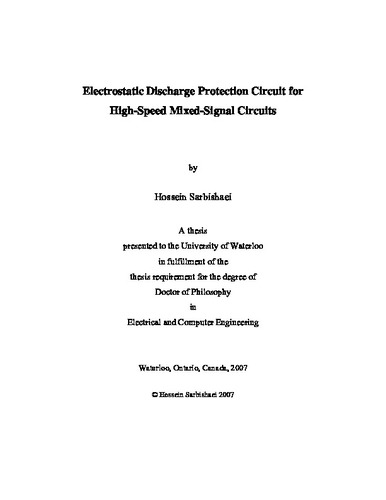| dc.description.abstract | ESD, the discharge of electrostatically generated charges into an IC, is one of the most important reliability problems for ultra-scaled devices. This electrostatic charge can generate voltages of up to tens of kilovolts. These very high voltages can generate very high electric fields and currents across semiconductor devices, which may result in dielectric damage or melting of semiconductors and contacts. It has been reported that up to 70% of IC failures are caused by ESD. Therefore, it’s necessary to design a protection circuit for each pin that discharges the ESD energy to the ground. As the devices are continuously scaling down, while ESD energy remains the same, they become more vulnerable to ESD stress. This higher susceptibility to ESD damage is due to thinner gate oxides and shallower junctions. Furthermore, higher operating frequency of the scaled technologies enforces lower parasitic capacitance of the ESD protection circuits. As a result, increasing the robustness of the ESD protection circuits with minimum additional parasitic capacitance is the main challenge in state of the art CMOS processes.
Providing a complete ESD immunity for any circuit involves the design of proper protection circuits for I/O pins in addition to an ESD clamp between power supply pins. In this research both of these aspects are investigated and optimized solutions for them are reported. As Silicon Controlled Rectifier (SCR) has the highest ESD protection level per unit area, ESD protection for I/O pins is provided by optimizing the first breakdown voltage and latch-up immunity of SCR family devices. The triggering voltage of SCR is reduced by a new implementation of gate-substrate triggering technique. Furthermore, a new device based on SCR with internal darlington pair is introduced that can provide ESD protection with very small parasitic capacitance. Besides reducing triggering voltage, latch-up immunity of SCR devices is improved using two novel techniques to increase the holding voltage and the holding current.
ESD protection between power rails is provided with transient clamps in which the triggering circuit keeps the clamp “on” during the ESD event. In this research, two new clamps are reported that enhance the triggering circuit of the clamp. The first method uses a CMOS thyristor element to provide enough delay time while the second method uses a flip flop to latch the clamp into “on” state at the ESD event. Moreover, the stability of transient clamps is analyzed and it’s been shown that the two proposed clamps have the highest stability compared to other state of the art ESD clamps.
Finally, in order to investigate the impact of ESD protection circuits on high speed applications a current mode logic (CML) driver is designed in 0.13μm CMOS technology. The protection for this driver is provided using both MOS-based and SCR-based protection methods. Measurement results show that, compared to MOS-based protection, SCR-based protection has less impact on the driver performance due to its lower parasitic capacitance. | en |

